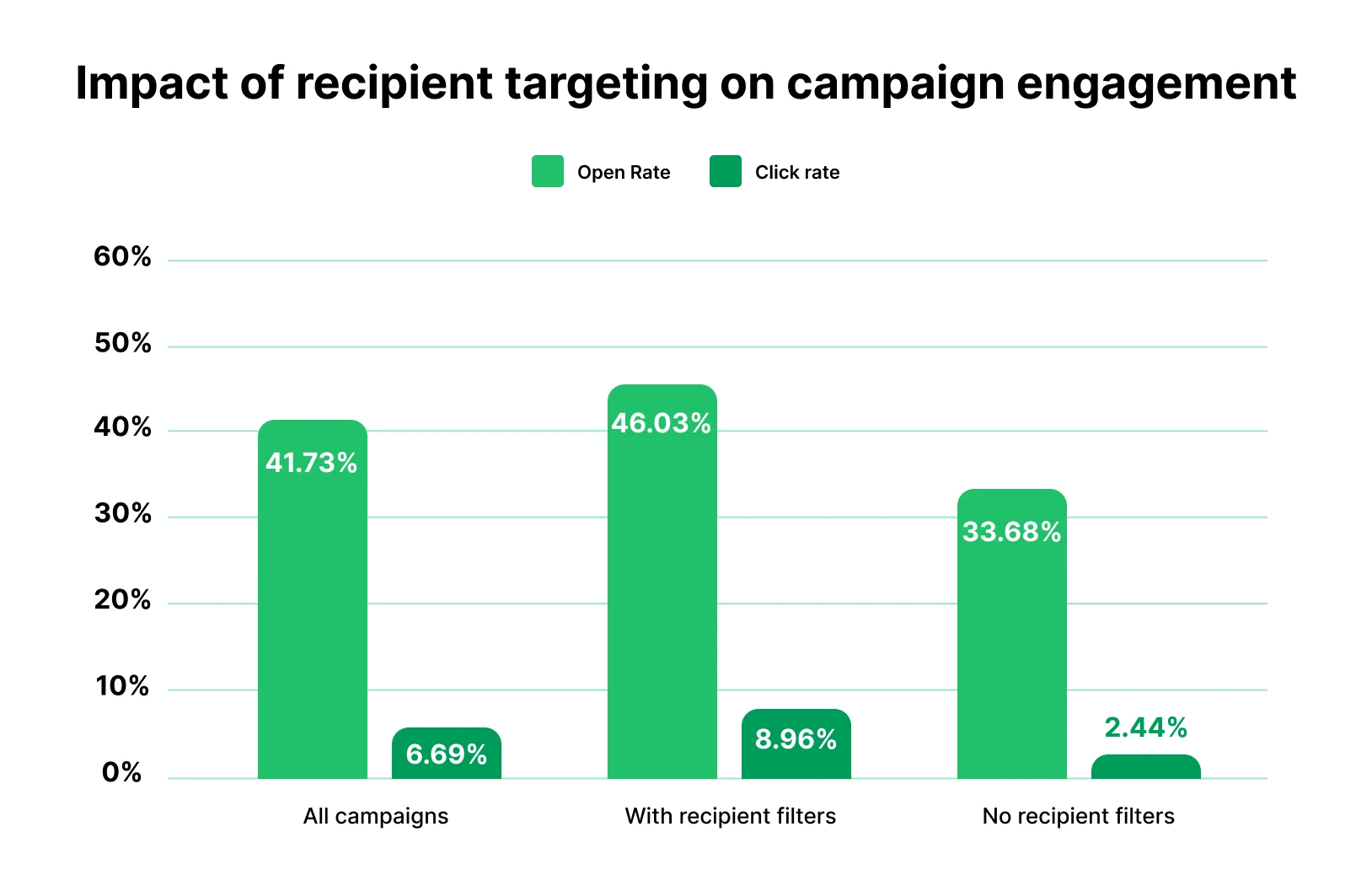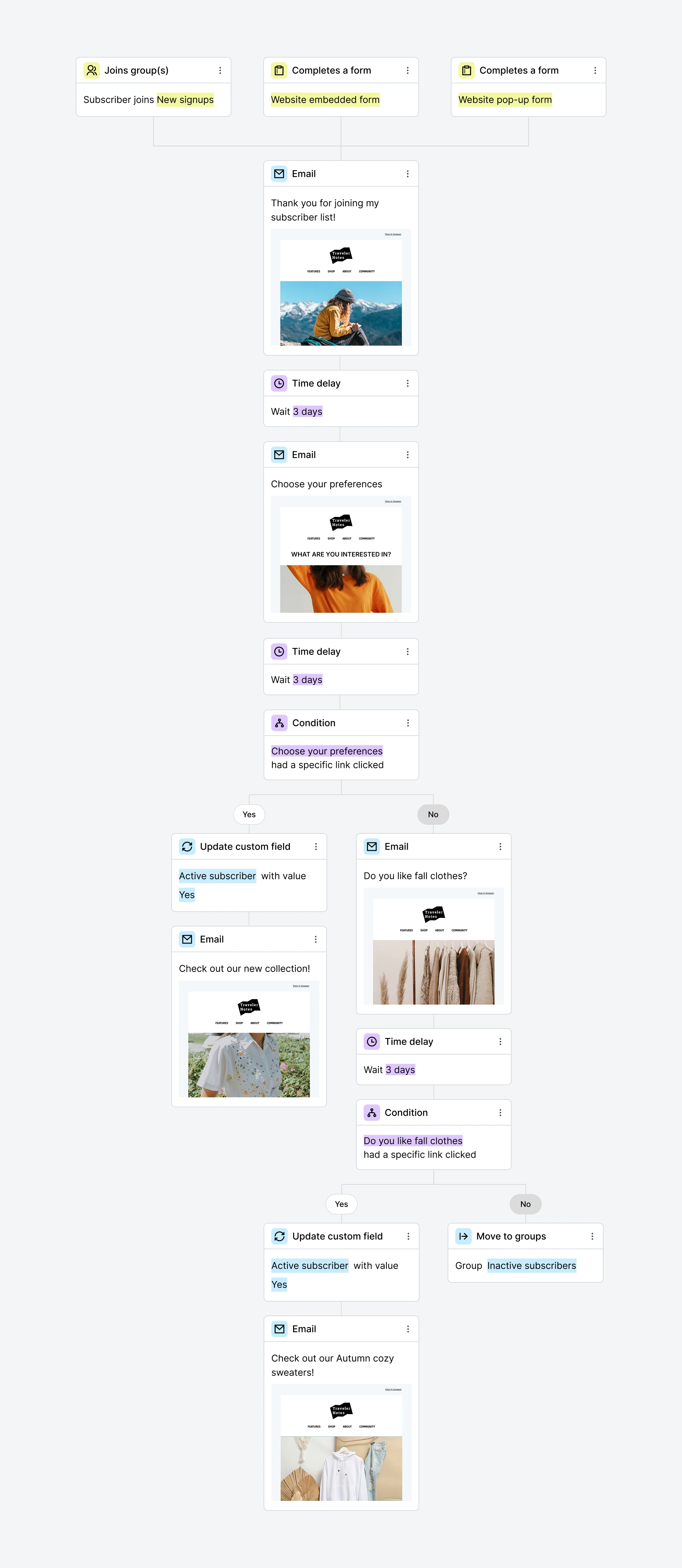Email cadence: How often should you send emails for optimum results?
 Alex, customer success, and Sofia, customer support
Alex, customer success, and Sofia, customer support
Sending too many emails might annoy your subscribers. But sending too few will result in missed sales and conversions. So what’s the best email cadence to generate engagement?
To get to the bottom of this million-dollar question, we analyzed over 1 million campaigns sent from MailerLite in 2024 to figure out how often you should be sending emails.
The answer we came to is (drum roll, please)... it depends.
Sorry, we were hoping for a neat and tidy answer too. But the optimal email cadence really does depend on your subscribers, the types of emails you plan to send, the product you’re promoting, and your offer.
The good news is that our data highlights plenty of interesting insights. We’ll share these and some best practices to help determine your optimal email cadence.
What is email cadence?
Email cadence is the frequency and timing of the emails you send. The idea is to optimize your cadence so your messages receive the highest possible level of engagement and contribute to your email marketing and wider business goals.
Why find the optimal email cadence?
Finding the optimal email cadence allows you to send emails at a rate that best impacts your business goals.
Get your email cadence right, and you’ll increase email marketing metrics like open rates, click-through rates, and conversions.
Get it wrong, and the opposite will happen. Send too many emails, and your recipients will stop seeing their value and may unsubscribe from your email list. Send too few, and you’ll miss out on opportunities to connect with your subscribers and generate sales.
Perfect email cadence: What the data says
To discover how email cadence impacts engagement, we analyzed data from over 32,000 MailerLite accounts that sent emails in 2024. This includes over 1 million campaigns and over 10 billion total sent emails.
We then organized the accounts by the average number of days between email sends and put them into five groups to help us compare engagement.
Daily
Twice a week
Weekly
1 to 3 times per month
Less than 1 per month
This analysis teaches us plenty of important things that will help you decide how often to send emails, including:
How often other businesses are sending emails
The average engagement rates for emails sent at different frequencies
Email frequency benchmarks by industry
Let’s dive into the data!
How often do businesses send emails?
The data shows that 69% of MailerLite users send at least one email per month, with 54% sending at least one per week.
Sending between 1 and 3 emails per month was the most common cadence, followed by sending 1 email per week. A similar number of accounts sent emails twice per week, every day, or less than once per month.
This pattern was followed across all industries, with weekly and 1 to 3 sends a month being the most popular sending frequency for SMBs, creators, and e-commerce stores.
There was some variance in the exact order of daily, irregular and twice a week email sending frequencies, but the share was broadly similar across all industries.
Email sending frequency for e-commerce
E-commerce stores followed the same pattern, with a slightly higher share of accounts sending emails twice per week, weekly and irregularly.
Email sending frequency for SMBs
SMBs were less likely to send daily emails, but more likely to send emails 1 to 3 times per month and irregularly than our overall dataset average.
Email sending frequency for creators
The pattern for creators was similar, but this group was more likely to send emails every day or twice per week and less likely to send them 1 to 3 times per month and irregularly.
Does sending frequency impact open rate?
Our data shows that email open rate decreases slightly the more often you send emails. However, the open rate for emails sent at a rate of between once per month and twice per week was quite consistent. The open rate drop-off only occurs when you start sending emails daily.
The biggest takeaway from this is that you could get many more eyes on your emails without negatively impacting your open rate by switching from a monthly to a weekly or twice-per-week sending schedule.
Accounts that send emails less than once per month receive the highest open rate. However, as we’ll discover in the next 2 sections, these emails aren’t the ones that receive the highest overall engagement.
Apple Mail Privacy Protection results in open rates that aren’t as accurate as they once were. All emails sent to Apple Mail users who opt into privacy protection show as having been opened.
With the above point in mind, click-through rate can be a better metric to measure campaign engagement. The below chart shows the average email click-through rate based on email sending frequency.
Does sending frequency impact click rate?
Sending frequency appears to positively impact click rate. Accounts that send more emails receive more clicks on each email than those that send fewer campaigns.
Twice per week is the cadence that receives the most clicks, closely followed by daily emails. Accounts that send less than one email per month receive the fewest clicks.
Does sending frequency impact unsubscribes?
There is a clear standout loser when it comes to unsubscribes: Accounts that send irregular emails have an unsubscribe rate of 0.9%, which is 125% higher than accounts that send at a cadence of between daily and weekly emails, which stands at just 0.4%.
We don’t know exactly why this is the case. We guess that when accounts send messages at an irregular schedule, recipients either forget that they signed up or realize that they no longer need to receive the content, resulting in them unsubscribing.
So, what’s the optimal cadence to send emails at?
We recommend an email cadence of between monthly and twice a week. The data shows that you can send at those frequencies and combine high open and click rates with a low unsubscribe rate. Plus, you’ll stay at the front of your subscribers’ minds without overwhelming their inbox.
While accounts that send emails at a rate of less than once per month have the highest open rates. This is unlikely to be the optimal cadence, since businesses that send at this frequency also:
Have the lowest click rate and highest unsubscribe rate
Don’t get the benefits of email marketing, such as closer customer relationships, more sales, and staying top of mind.
But the right cadence for you will ultimately depend on more than just the above data. Let's explore some other factors that come into play when choosing the perfect email cadence.
7 best practices for finding your perfect email cadence
Here are 7 other email cadence best practices to consider when choosing how often to send emails in your business.
1. Start with your email marketing goals
Your goal plays a big part in how often you send emails. Think about why you want to do email marketing and then think about the cadence of emails that will achieve this aim.
If you want to send a newsletter to earn money through ads, send emails at a high frequency since you can sell more ads when you send more emails.
But, if you want to send an email to build authority in a niche, you can send fewer emails of a higher quality so people look at you as an expert.
2. Consider how much you have to share
Your optimal email cadence will be limited by the amount you have to say or share.
An online store that sells just 1 or 2 products will typically have less to say than one with a constantly rotating line of new products.
Likewise, a newsletter writer who sends a roundup of the day’s news will be able to send more frequent messages than a newsletter writer who creates 2,000-word opinion pieces.
Here are two examples of how a business’s products can impact its sending cadence.
KC Tool is an online store with a vast library of German hand tools. It promotes these products with an automated deals email that goes out every day. Since subscribers love the product, the emails get high engagement.
E-commerce store Live the Creed has fewer products. It sends between 2 and 4 email campaigns per month, depending on what’s happening in the business. This ensures that the customers receive value every time they open an email.
When we send an email, we want our customers to care to open it as it’s something they don’t see in their inbox every day.
3. Meet audience expectations
Audience expectations can influence your email cadence. If your audience expects you to send a weekly email, they might react badly if you start sending more or less often than this.
If you change how often you send campaigns, track metrics like open rate, click rate and unsubscribe rate to see how your audience reacts to the new cadence.
You can also manage subscriber expectations by using your welcome email to explain how often you send campaigns. Or use your preference center to offer multiple frequency options—such as a daily email and a weekly roundup—and let recipients choose a cadence that suits them.
Email cadence doesn’t impact deliverability directly. But, email engagement does. If inbox providers notice that people don’t interact with your messages or mark them as spam, they will be more likely to send your emails to the junk folder. That’s why it’s important to send messages at a frequency that meets your audience’s needs.
4. Adjust to the reality of available resources
Sometimes we’re limited in how much focus we can put on email marketing campaigns. Businesses with a dedicated email marketer can send more campaigns than a business where a single person has to balance email marketing with social media, paid ads and more.
With that in mind, consider how much time you can spend on email marketing and create a cadence that fits your schedule. If you're struggling to do enough, remember that email templates, automations and AI tools can help you do more with less.
5. Adjust your sending to seasonality
There will be times during the year when you and your audience will benefit from a higher email cadence.
When we spoke to Danika Bloom for our guide to email marketing for authors, she highlighted that during book launches, she’ll often send multiple emails per week. Despite this increase in cadence, her open rate stays high as people on her list are excited about her new book.
Likewise, there may be times when you send fewer emails. Festival at Sandpoint often sends daily emails in the lead up to a big event, but it sends fewer during the off-season when there isn’t as much information to share.
We send emails year-round, but during festival season, we sometimes send emails daily or multiple times a day.
6. Send targeted campaigns where necessary
Another way to send more emails without overwhelming subscribers is to send different messages to each subscriber segment. This way, people only receive the content that is most relevant to them.
Plus, sending personalized messages is a super-effective way to increase engagement. Our study of e-commerce emails found that messages targeted at specific recipients have average open and click-through rates (CTR) that are 36.69% and 267.21% higher than non-targeted campaigns.

To effectively send targeted emails, you need to create groups and segments based on interests. Here are some suggestions for ways to do this:
Group people based on signup form interaction
Add people who click on a specific email link to a group
Create segments based on survey answers
Create segments based on campaign interaction
Create segments based on shopping behavior
Find out more about creating segments and groups in this guide to email segmentation.
7. Supplement campaigns with automations
There are times when a customer will benefit more from a well-timed and highly targeted automated email than a general newsletter.
Email automations allow you to increase the number of emails specific subscribers get at important customer touchpoints without bombarding your entire list with more email content. Plus, once the workflow is set up, it goes out automatically whenever triggered.
An example of this type of email is a welcome sequence. When potential customers join your list, they will be excited to hear from you. Waiting a week or two to receive your first email will kill the momentum.
Because of this, you can create a welcome email sequence that sends multiple emails in the hours or days after someone joins your list.
Other ways you can use automations include sending follow-up emails when someone:
Buys from you
Responds to an event or webinar invitation
Downloads a resource
Clicks on an offer in an email
Requests a meeting or proposal
You can set up emails to go out at the right moment by creating workflows and using triggers to trigger the emails. You can then use A/B testing to find the right email to end at each stage in the sequence.
Find out more in the guide to email automation and this article on email triggers.
Email cadence is only one part of a successful email marketing strategy
The one-size-fits-all email cadence doesn’t exist, but you can find what works best for you and run with it.
The truth is that the success of your email marketing strategy can rarely be distilled to 1 aspect, like the frequency of emails or the subject line. Better open rates and more clicks come when the right email elements align to meet your subscribers’ needs.
If subscribers need to hear from you every week, send them emails every week. If they need you less often, experiment to find a cadence that works.
Create campaigns people love
Now's the time to put your new email cadence knowledge into action. Sign up for MailerLite to create campaigns using the best practices in this article.
Editor's note: This article was originally published in August 2020, but has been updated with fresh data and examples.

